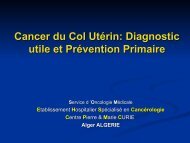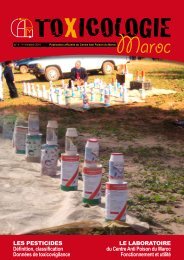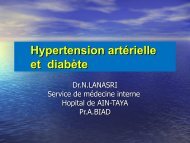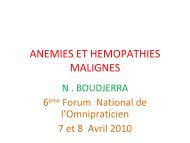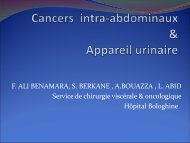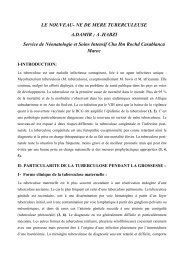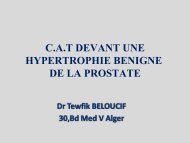le syndrome transfuseur transfuse : physiopathologie, diagnostic et ...
le syndrome transfuseur transfuse : physiopathologie, diagnostic et ...
le syndrome transfuseur transfuse : physiopathologie, diagnostic et ...
Create successful ePaper yourself
Turn your PDF publications into a flip-book with our unique Google optimized e-Paper software.
VIII. CONCLUSION :<br />
Le STT est une pathologie rare, mais très sévère, d’où l’intérêt du <strong>diagnostic</strong> <strong>et</strong> du traitement anténatal, car<br />
<strong>le</strong> devenir est fonction de l’efficacité du traitement anténata<strong>le</strong>. En post-natal la prise en charge est<br />
symptomatique. Le pronostic est réservé vu <strong>le</strong> risque é<strong>le</strong>vé de prématurité <strong>et</strong> de séquel<strong>le</strong>s neurologiques<br />
lourdes.<br />
REFERENCES:<br />
[1] Mahony BS <strong>et</strong> al . The “stuck twin” phenomenon: ultrasonographic findings, pregnancy outcome and<br />
management with serial amniocenteses. Am J Obst<strong>et</strong> Gynecol 1990;163(5 Pt 1):1513–22.<br />
[2] Mari G <strong>et</strong> al. Perinatal morbidity and mortality rates in severe twin-twin transfusion <strong>syndrome</strong>:<br />
results of the international amnioreduction registry. Am J Obst<strong>et</strong> Gynecol 2001;185(3):708–15.<br />
[3] Dommergues M., Picone O. Stratégie de <strong>diagnostic</strong> prénatal <strong>et</strong> prise en charge des pathologies liées<br />
aux grossesses multip<strong>le</strong>s. EMC-Gynécologie Obstétrique 2 (2005) 91–98<br />
[4] Carroll <strong>et</strong> al. Is zygosity or chorionicity the main d<strong>et</strong>erminant of f<strong>et</strong>al outcome in twin pregnancies?<br />
American Journal of Obst<strong>et</strong>rics and Gynecology (2005) 193, 757–61<br />
[5] Chalouhi G.E. <strong>et</strong> al. Specific complications of monochorionic twin pregnancies: twin-twin transfusion<br />
<strong>syndrome</strong> and twin reversed arterial perfusion sequence. Seminars in F<strong>et</strong>al & Neonatal Medicine 15 (2010)<br />
349-356<br />
[6] Bebbington M. Twin-to-twin transfusion <strong>syndrome</strong>: current understanding of pathophysiology, in-utero<br />
therapy and impact for future development. Seminars in F<strong>et</strong>al & Neonatal Medicine 15 (2010) 15–20<br />
[7] Kusanovic <strong>et</strong> al. Twin-to-twin transfusion <strong>syndrome</strong>: an anti-angiogenic state? Am J Obst<strong>et</strong> Gynecol.<br />
2009.<br />
[8] Lopriore E <strong>et</strong> al. Twin-to-twin transfusion <strong>syndrome</strong>: from placental anastomoses to long-term<br />
neurodevelopmental outcome. Curr Pediatr Rev 2005;1:191–203.<br />
[9] Lopriore E <strong>et</strong> al. Congenital heart disease in twin-to-twin transfusion <strong>syndrome</strong> treated with f<strong>et</strong>oscopic<br />
laser surgery. Congenit Heart Dis 2007;2:38–43.<br />
[10] Baschat <strong>et</strong> al., Recommendations and guidelines for perinatal practice TTTS. J. Perinat. Med. 39 (2011)<br />
107–112<br />
[11] Quintero RA, Mora<strong>le</strong>s WJ, Al<strong>le</strong>n MH, Bornick PW, Johnson PK, Kruger M. Staging of twin-twin<br />
transfusion <strong>syndrome</strong>. J Perinatol 1999;19:550-5.<br />
[12] Rossi, D’addario. Donor and recipient outcomes following laser therapy. American journal of<br />
perinatology, 2009; 26: 27-32<br />
[13] Barré M. <strong>et</strong> al. Les Jumeaux acardiaques : étude des critères pronostiques échographiques.<br />
Gynécologie Obstétrique & Fertilité 40 (2012) 93–8<br />
7






